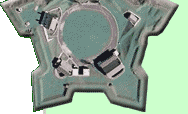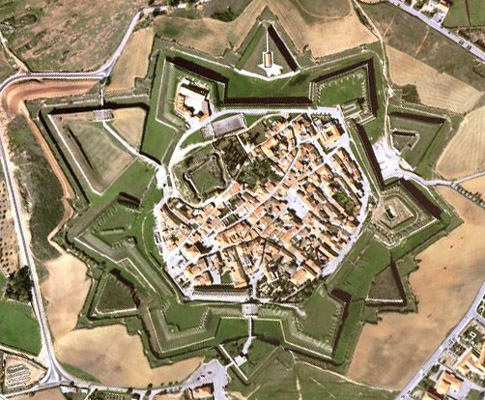
 |
 |
Fortress of Almeida Almeida, Portugal |
 |
 |
 |
 |
 |
||
 |
The Fortress of Almeida, a mere seven kilometers from the Spanish border, was originally a castle built in the 14th century, overlooking the natural boundary between the two nations: the River Coa. During this period Portugal was consolidating itself from a collection of individual nobles' holdings into a single monarchy. This process would, in the 16th century, lead to a period of empire as Portuguese explorers discovered and claimed lands in South America, Africa, Asia and throughout the Atlantic. By the end of the 16th century, Portugal's neighbor Spain was working on its own, somewhat spiffier empire, and in 1581 it snapped up Portugal as well. In 1640 Portugal had mostly squeezed Spain out of its system, and worked on restoring its own monarchy. During this period the Fortress of Almeida was upgraded, adding the walls around the castle that we see today. Just about any forward momentum Portugal may have been enjoying crashed to a full stop in 1755, when most of its capital city, Lisbon, was destroyed in an earthquake. The Seven Years War (1756-1763) is considered by some to be the real first world war. Everyone who was anyone in Europe was involved in the squabble, as well as North America (where the conflict is known as the French and Indian War), Russia, India and East Africa. Portugal entered the war in its later stages alongside Great Britain...naturally, Spain entered the fray at about the same time, on the side of France, Austria and Sweden. The war came to Almeida in August of 1762. Spain attempted to invade and occupy all of Portugal, but after capturing Almeida and its fortress on August 26, was stopped by the arrival of 8,000 British troops. At the end of the conflict, the Fortress of Almeida was the only major Portuguese fortification to remain in Spanish hands. Under the terms of the Treaty of Paris (1763), the fort was returned to Portugal in exchange for the return of Cuba and the Philippines from Great Britain to Spain. The Portuguese barely had time to patch up the Fortress of Almeida's shot holes before the Napoleonic Wars (1803-1815) started up. France's vast army, assisted by its occasional ally Spain, rolled towards Portugal, which Britain's army, led by the lengthily-nosed Duke of Wellington (1769-1852), hoped to defend. Napoleon (1769-1821)'s troops pushed into Portugal in 1810, and on July 24 began besieging the Fortress of Almeida. Wellington hoped that the French would be delayed at Almeida for a few months, frittering away men and supplies, but the fort would only hold out for just over a month. On August 26, a French howitzer round exploded in the fort's courtyard, igniting a trial of gunpowder in what sounds like the definitive Wile E. Coyote moment for the defenders. The gunpowder trail led to the fort's powder magazine and ammunition storage in the castle, and what happened next is about what you'd expect: The Roadrunner cheerily beep-beeped and zoomed away uneaten. Most of the fort's artillery tumbled through the air, and a vast number of its defenders died in the enormous blast, sending enough detritus flying to kill or injure several French troops, who were holding their ears and grinning in nearby trenches. The pile of rubble surrounded by blasted walls that had been the mighty Fortress of Almeida surrendered on August 28 1810. The castle portion was never rebuilt, and today the Fortress of Almeida is a tourist destination, its ruins visible from elevated walkways. |
 |
 |
||
|
|
|||||||
Info Source 1 Info Source 2 Info Source 3 Info Source 4 Info Source 5 Info Source 6 Info Source 7 Info Source 8 Info Source 9 Info Source 10 Info Source 11 Info Source 12 Thanks to Google Maps for the image! ©2010 starforts.com |
 |